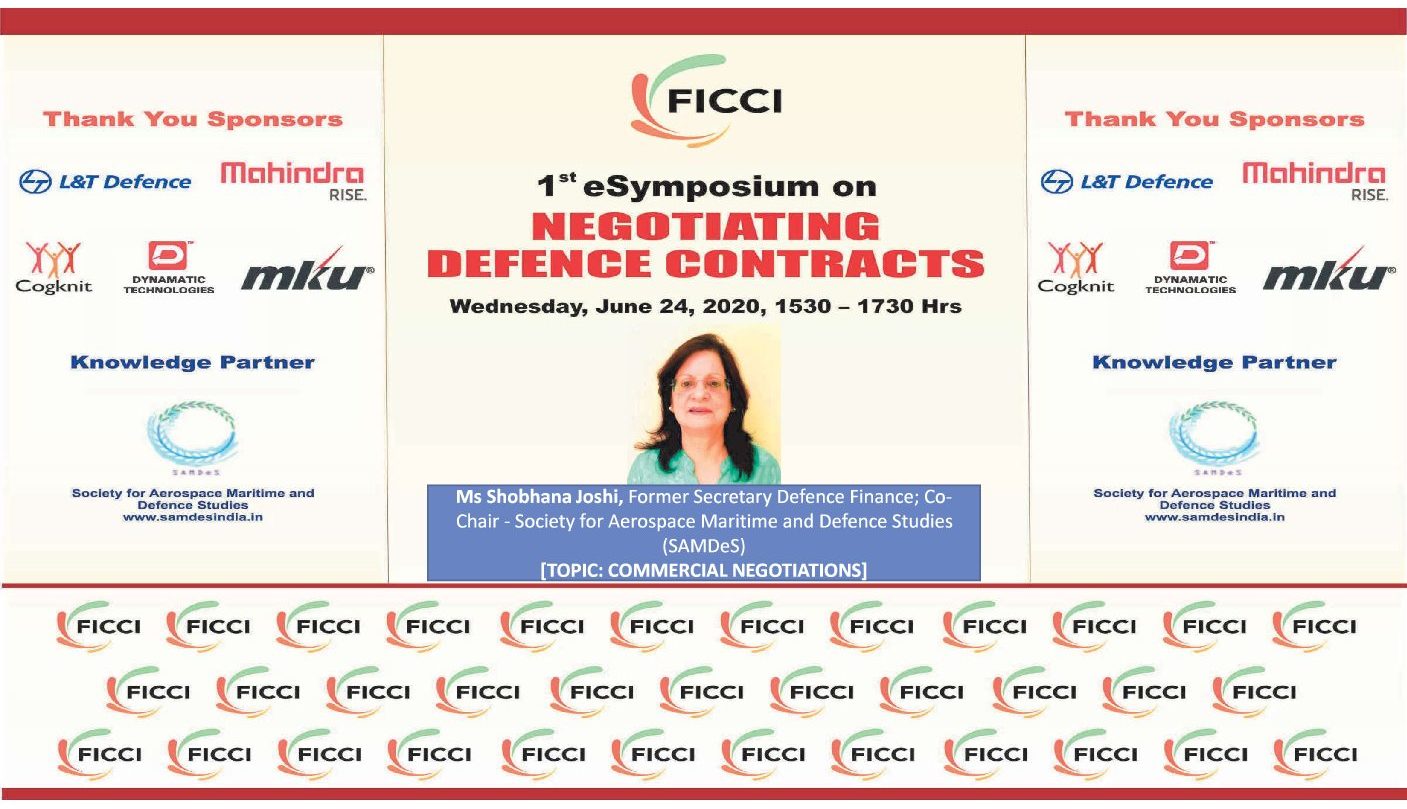The first ever eSymposium on ‘Negotiating Defence Contracts’ organised by FICCI with SAMDeS as knowledge partner held on June, 24 2020 received a tremendous response with more than 250 participants from industry, services, retired bureaucrats and media.
The objective the eSymposium was to address the nuances involved in the negotiating processes for acquisition of weapon systems and platforms. In negotiating defence contracts, the complexities increase manifold as negotiations are a feature of the entire acquisition process. These negotiations are necessary as they provide an opportunity to both the buyer and seller to bring clarity and transparency in the process.
Mr Arun T Ramchandani, Co-Chair FICCI A&D Committee and EVP, Guns, Missiles, Armoured Systems BU, L&T Defence welcomed the speakers and participants and commenced the symposium.
The Chairperson SAMDeS,Admiral Dhowan, Former Navy Chief SAMDeS set the tone by highlighting the importance of negotiating skills especially with the added element of indigenous content, making the process even more complex.
In the panel discussions a perspective was provided on the complex technical issues in defence acquisition and how interactions with industry representatives provide inputs for formulating SQR’s, life cycle maintenance and spares requirements, upgrades, timelines of delivery and for indicative budgetary and cost implications. These negotiations are helpful in formulating a doable proposal and facilitate the acquisition to be finalised much faster. The concept of T1/L1 was also discussed in which Enhanced Performance Parameters (EPP) are prescribed.
Further it was brought out that commercial negotiations in defence contracting are needed because the systems and platforms are complex, due to range or technologies involved, with no parallel in the market. It is a formal process which normally goes through in phases before a consensus is reached. The ultimate objective is to have a two-way process to obtain real price discovery of complex defence systems. Since defence requirements need continued life cycle support the negotiations should be done in an atmosphere of trust with long term partnership goals. It was stated that benchmarking is the pivot around which the negotiations move and the need to ensure a system of accurate benchmarking was explained in detail.
The sessions elicited lot of questions though due to paucity of not all could be taken up. The key takeaways which emerged from the eSymposium were as follows:
Pragmatic and verifiable data and not overstating the technical capabilities of industry at RFI stage will ensure that the QRs are realistic with achievable performance and maintenance parameters
Industry must be very careful in an RFP with Enhanced Performance Parameters (EPP), to accept Essential Parameters (A) which fetches a Credit Store (10%) in selection of L-1, since they will be tested during FET and can not be relaxed.
Defence Procurement Procedure should be a simple and concise document and be broad based in approach to enable flexibility and the process should be aimed at facilitating acquisition of the equipment and not fault finding. It was also brought out that demand aggregation should be mandatory so that national industry can be built up. The example of multiple tenders for helicopters was cited which only salami sliced the huge demand leading to unviable scale and size to locate manufacturing in India. It was suggested that helicopter upto say 5 tons and more than 5 tons could be aggregated and tendered out to generate adequate demand for localising assembly and ancillary industries in India.
There is need for specialization and to build institutional memory with a database of past acquisition cases to make acquisitions more professional.
There was divergent views on the need for benchmarking. Industry participants felt that benchmarking was not required in competitive bidding as the process automatically leads to real price discovery and the final price differs from situation to situation, terms and conditions, quantities, sourcing plans etc. and comparisons end up between apples and oranges. The AK 203 benchmarking case was raised which has resulted in an impasse between the OFB/Russian JV and the MoD only due to a huge difference between benchmarked and offered price. It was also opined that benchmarking must be done for all nominated projects since in the absence of competition fair value is not determined.
There should be standardization in the methodology and parameters used for benchmarking for which detailed guidelines are needed to be formulated.
Industry view was that once L1 vendor has been determined, there should be no further negotiation on price unless the amended terms and conditions are also offered to the other vendors to obtain their discounts.
Shri Dilip Chenoy, Secretary General FICCI noted the huge response to the e-symposium and looked forward to further e-interactions. He thanked SAMDeS, speakers and the participants for joining in large numbers.
